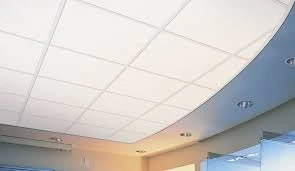Nov . 24, 2024 02:16 Back to list
mineral fibre ceiling
Understanding Mineral Fibre Ceilings Benefits, Features, and Applications
Mineral fibre ceilings, commonly known as mineral fiber ceiling tiles, have become a popular choice in both residential and commercial construction, thanks to their versatile nature and numerous benefits. Composed primarily of natural and synthetic mineral fibers, these ceilings offer an aesthetic appeal while providing functional advantages.
Composition and Characteristics
Mineral fibre ceilings are generally made from a mixture of materials such as gypsum, fiberglass, and other mineral inputs. The composition can vary, but the basic characteristic remains the same—they are lightweight, durable, and acoustically effective. These tiles are designed to be easy to install and are usually mounted in a grid system, making replacements or repairs straightforward.
The texture of mineral fibre ceilings can range from smooth to rough, allowing for various design options. They can be painted or left in their natural state, providing flexibility in aesthetics. Additionally, these tiles are available in various sizes and thicknesses to cater to different needs and preferences.
Acoustic Performance
One of the standout features of mineral fibre ceilings is their exceptional acoustic performance. They are specifically designed to absorb sound, making them ideal for spaces such as offices, schools, and hospitals where noise reduction is crucial. The porous structure of mineral fiber allows sound waves to be absorbed rather than reflected, creating a quieter and more comfortable environment.
This acoustic property is not just beneficial for reducing noise but also for enhancing speech clarity in spaces where communication is key. By minimizing background noise, these ceilings contribute to improved concentration and productivity, especially in open-plan offices or classrooms.
Thermal Insulation
mineral fibre ceiling

In addition to their acoustic properties, mineral fibre ceilings also provide thermal insulation. They help maintain stable indoor temperatures by preventing heat loss in winter and reducing heat gain in summer. This characteristic can lead to significant energy savings over time, making mineral fibre ceilings an environmentally friendly option.
Furthermore, these ceilings contribute to the overall energy efficiency of a building. By working in conjunction with proper HVAC systems, mineral fibre ceilings can play a vital role in energy conservation, appealing to both environmentally conscious consumers and businesses looking to reduce operational costs.
Fire Resistance
Safety is another critical aspect of mineral fibre ceilings. Many products in this category are inherently fire-resistant due to their mineral composition. This makes them an excellent choice for commercial buildings where fire safety regulations must be strictly adhered to. In the event of a fire, mineral fibre ceilings can help slow the spread of flames and smoke, providing crucial time for evacuation and firefighting efforts.
Environmental Impact
In today's world, sustainability is a significant concern. Many manufacturers of mineral fibre ceilings are committed to reducing their environmental footprint by using recycled materials in their products. Additionally, these ceilings can contribute to green building certifications, such as LEED, which recognizes sustainable building practices.
Conclusion
Mineral fibre ceilings present a practical and aesthetically pleasing solution for a wide range of building applications. With their excellent acoustic performance, thermal insulation capabilities, fire resistance, and environmental benefits, they are a wise choice for anyone looking to enhance the functionality and style of their space. Whether for commercial, educational, or residential purposes, mineral fibre ceilings certainly stand out as a valuable building material that meets the demands of modern construction and design.
-
Premium Ceiling Trap Doors & Access Panels - Durable & SecureNewsAug.31,2025
-
Quality Ceiling Trap Doors & Access Panels | Easy & Secure AccessNewsAug.30,2025
-
Durable Ceiling T Grid Systems | Easy InstallationNewsAug.29,2025
-
PVC Gypsum Ceiling: Durable, Laminated Tiles for Modern SpacesNewsAug.28,2025
-
Pvc Gypsum Ceiling Is DurableNewsAug.21,2025
-
Mineral Fiber Board Is DurableNewsAug.21,2025







